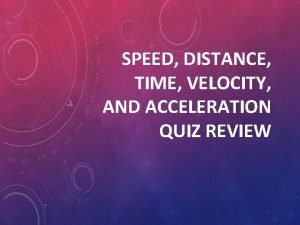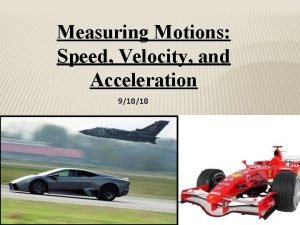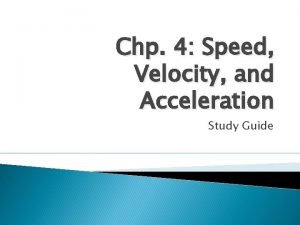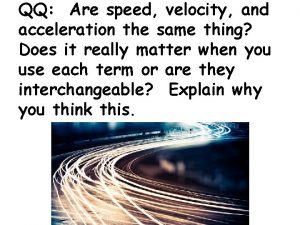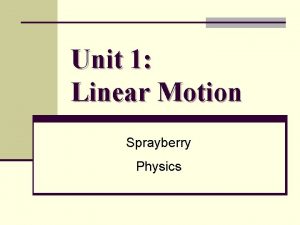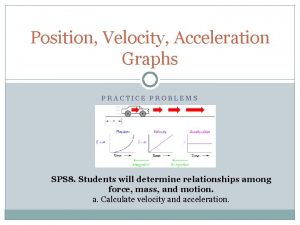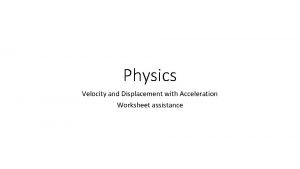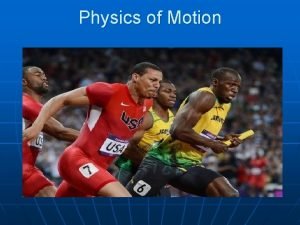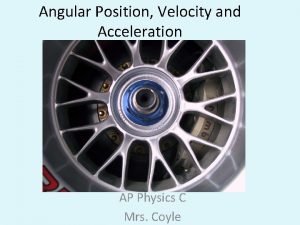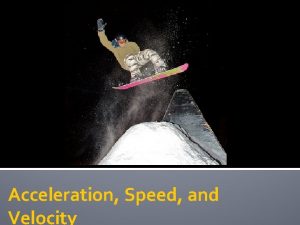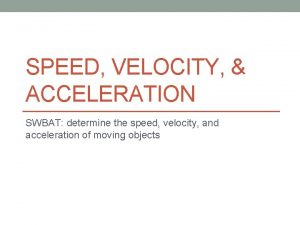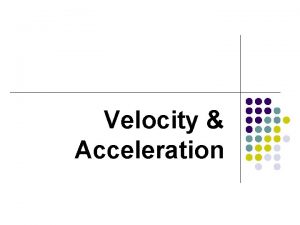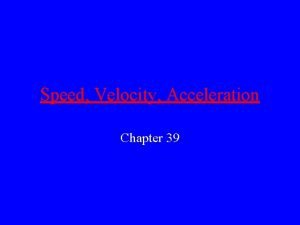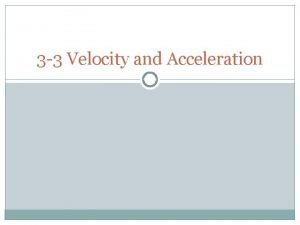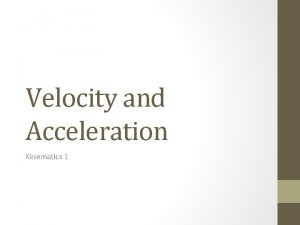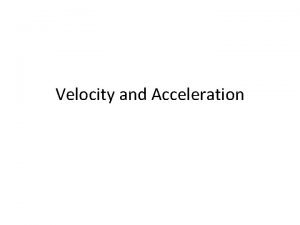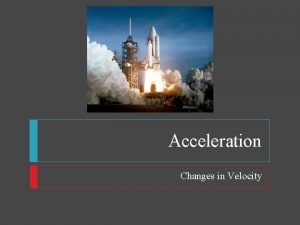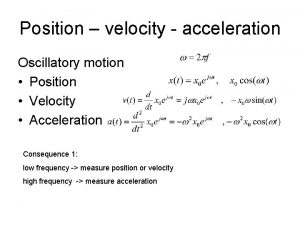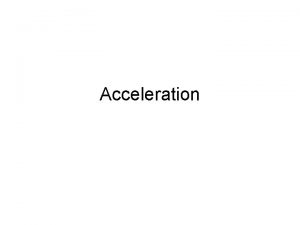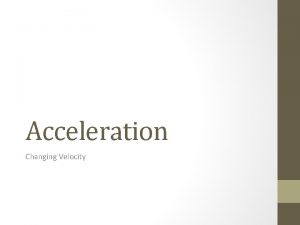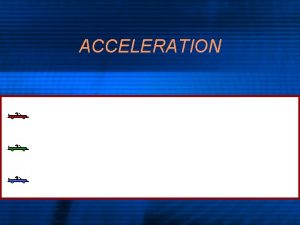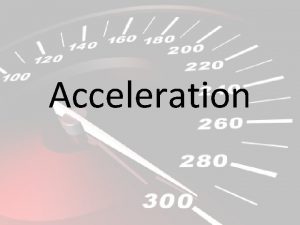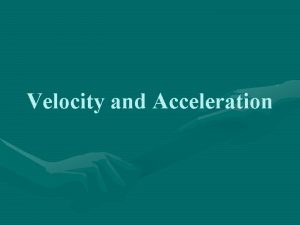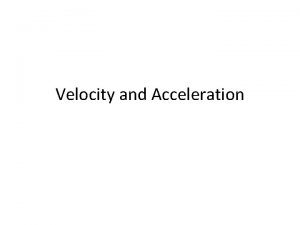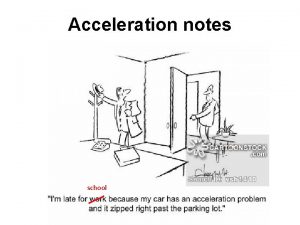Speed velocity and acceleration Core Define speed and




















- Slides: 20

Speed, velocity and acceleration

Core • • Define speed and calculate speed from Total distance/total time Plot and interpret a speed/time graph or a distance/ time graph Recognise from the shape of a speed/time graph when a body is – at rest – moving with constant speed – moving with changing speed Calculate the area under a speed/time graph to work out the distance travelled for motion with constant acceleration • Demonstrate some understanding that acceleration is related to changing speed

Supplement • Distinguish between speed and velocity

You will learn • How to calculate average speed • The difference between speed and velocity • How to calculate acceleration • How to interpret velocity-time graphs.

Speed and velocity • Speed is a ________ quantity. • Speed is measured in _____ (units). • The average speed of an object can be calculated using the equation: • Instantaneous speed is more difficult to measure but can be found by looking at the _________ of a _______ vs. time graph.

Velocity • Velocity is a ________ quantity it has both magnitude and _________. • Velocity is measured in _____ (units). • Hence a change in _______ causes a change in velocity. • E. g. 1 A car going at a constant ______ in a circle has a changing velocity. • E. g. 2 An object travelling at 10 m/s that returns to its original position has an average velocity of ___ m/s.

Acceleration • Acceleration is a ________ quantity. • Acceleration is measured in _____ (units). • The Acceleration of an object can be calculated using the equation: Acceleration = _____ • Acceleration can be found by looking at the _________ of a _______ vs. time graph. • A negative Acceleration is called ______

Activities • Read p 26+27 • Answer questions on page 27

Velocity time graphs

Velocity time graphs. • Velocity – time graphs can show information about the motion of an object in more ____ • The _______ of the line on a v-t graph tells us about the acceleration. • A greater acceleration is shown by a _____ line. • If acceleration is constant the line is _____ • An increasing acceleration is shown by a line that _______ • A decreasing acceleration is shown by a line that _______ • The distance travelled by an object can be determined by the _____ ________

To do • P 29 q 2

Experiment

Supplement • Recognise linear motion for which the acceleration is constant and calculate the acceleration • Recognise motion for which the acceleration is not constant

You will learn • How to recognise constant acceleration on a speed-time graph • How to calculate acceleration from a speed – time graph • How to recognise non constant acceleration from a speed time graph

Practice • P 35 q 1&2

v = at when applied to an object accelerating uniformly from rest • • What is the equation for acceleration? acceleration = Change in velocity / time So Change in velocity = ? acceleration x time Change in velocity = ? Final velocity – initial velocity (v-u) What if initial velocity is zero? v = at

Summary questions 1. A car accelerates from 10 m/s to 25 m/s over a period of 5 seconds. What is the acceleration? 2. A wombat falls out of a tree into a vat of custard. It starts from rest, and accelerates at 10 m/s 2 until it lands in the custard 5 seconds later. How fast is it going when it hits the custard?

Answers Chapter 18 : Velocity and Acceleration 1 1. A car accelerates from 10 m/s to 25 m/s over a period of 5 seconds. What is the acceleration? Acceleration = (change in velocity) ÷ time = (25 – 10) ÷ 5 = (15) ÷ 5 = 3 m/s 2 2. A wombat falls out of a tree into a vat of custard. It starts from rest, and accelerates at 10 m/s 2 until it lands in the custard 3 seconds later. How fast is it going when it hits the custard? Acceleration = (change in velocity) ÷ time 10 = (v – 0) ÷ 3 So v = 3 × 10 = 30 m/s That’s over 60 mph – ouch!

Velocity and Acceleration Use these words to label the graphs correctly. stopped slow fast accelerating stopped decelerating

Answers Velocity and Acceleration Use these words to label the graphs correctly. stopped slow fast accelerating fast stopped slow stopped decelerating accelerating decelerating fast stopped
 Final velocity initial velocity acceleration time
Final velocity initial velocity acceleration time Constant acceleration speed time graph
Constant acceleration speed time graph Speed, velocity and acceleration quiz
Speed, velocity and acceleration quiz Speed velocity and acceleration problems
Speed velocity and acceleration problems Speed velocity and acceleration formulas
Speed velocity and acceleration formulas Speed velocity and acceleration study guide answers
Speed velocity and acceleration study guide answers What's the difference between speed and acceleration
What's the difference between speed and acceleration Are speed and acceleration the same thing
Are speed and acceleration the same thing Reference point examples
Reference point examples Angular quantities and linear quantities cannot be related.
Angular quantities and linear quantities cannot be related. Angular acceleration and linear acceleration
Angular acceleration and linear acceleration Tangential acceleration and centripetal acceleration
Tangential acceleration and centripetal acceleration Linear motion definition
Linear motion definition Velocity and acceleration difference
Velocity and acceleration difference Unit of relative velocity
Unit of relative velocity Distance velocity acceleration graphs
Distance velocity acceleration graphs Displacement velocity and acceleration worksheet
Displacement velocity and acceleration worksheet Difference between velocity and acceleration
Difference between velocity and acceleration Motion in two dimensions quick check
Motion in two dimensions quick check Angular acceleration unit
Angular acceleration unit Velocity polygons
Velocity polygons


